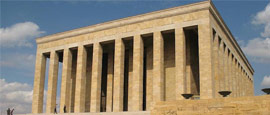This immense marble monument contains the tomb of modern Turkey’s founder, Mustafa Kemal (Atatürk). As well as the actual mausoleum, the complex contains a museum dedicated to Turkey’s War of Independence, Atatürk’s program of modernising reforms afterwards, and memorabilia devoted to the man himself.
Things to see in Ankara
Tourist offices
Address: Kale Kapısı Sokak, Ulus, Ankara, Turkey
Tel: +90 312 310 3044
Opening Hours:
Mon-Sat 0900-1700.
www.kultur.gov.trAnkara’s tourist office is located in the citadel and offers brochures and a free map of the city.
No visit to Ankara is complete without a wander around its Old City area contained within its much-besieged fortress walls. Of particular interest within the compact district are the 12th century Alaettin Mosque, and the lookout point of the Şark Kulesi (East Tower), with views over the city.
Avid collector Yüksel Erimtan managed to amass a stunning number of artefacts from Turkish archaeological sites during his life and this new museum assembles them here, in beautifully-curated displays. The collection highlights the Roman and Byzantine eras in particular, but also contains a few choice pieces from the Bronze Age.
Turkey’s premier museum traces the mind-boggling history and multitude cultures of Anatolia (modern-day Turkey) from the Palaeolithic age up to the Byzantine era. The stand out collections are the artefacts and wall-paintings unearthed from the Neolithic site of Çatalhöyük, and the hall dedicated to Anatolia’s famed Hittite civilisation.
Ankara's Ethnography Museum boasts a fascinating collection of artefacts that cover the scope of Turkish culture, artistry and traditions from carpet-making and ceramics to coffee. It is housed inside a white marble post-Ottoman building which was used as Atatürk’s mausoleum until the Anıtkabir was built in the 1950s.
Ankara’s most important mosque is dedicated to venerated 15th century holy man Hacı Bayram Veli, founder of an order of dervishes. Today it remains a major pilgrimage site for Muslims. Non-Muslims wishing to enter the mosque should dress appropriately (long trousers and long sleeves) and females should wear a headscarf.
This museum houses a series of galleries showcasing a selection of paintings and other Turkish art works dating from the 19th and 20th centuries. Although small (and not on par with the many art galleries of Istanbul) the collection contains works by all of Turkey’s most well-known artists.
This is a museum for kids and big kids alike. The eclectic collection here covers everything from science and computing to toys and music, with multimedia displays scattered throughout to aid visitor understanding. It’s housed in the Çengelhan, an old caravanserai (traveller’s inn) that has been restored to its former glory.
Located in central Ulus, Ankara’s Roman baths remains are thought to have been constructed by the emperor Caracalla between 212 and 217 and was dedicated to Aesculapius, god of health. Today the site is rather scruffy and overgrown but the footprint of the baths can still be seen.
One of Ankara’s clutch of Roman remnants, this temple was built in approximately 20BC when Ancyra (modern-day Ankara) became regional capital of the Roman province of Galatia. The ruin is archaeologically important as the sole site of a complete Res GestaeDiviAugusti (Deeds of the Devine Augustus) funerary inscription.
Do you have any Feedback about this page?
© 2025 Columbus Travel Media Ltd. All rights reserved. No part of this site may be reproduced without our written permission, click here for information on Columbus Content Solutions.








 You know where
You know where